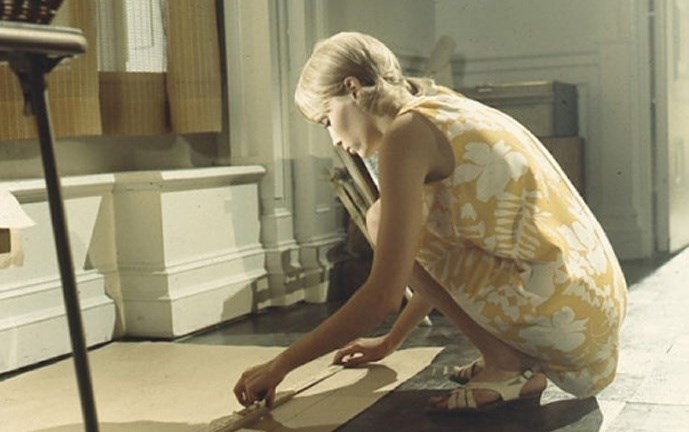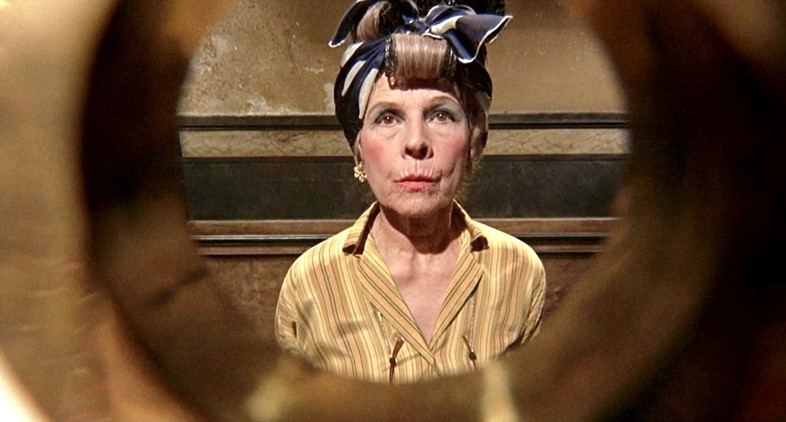A sartorial masterclass from the sinister psychological thriller
When, in 1967, Ira Levin published the novel Rosemary's Baby, he could scarcely imagine the impact that it would subsequently have on the world of fashion. A deeply disturbing thriller simultaneously centred around the occult and gender tropes of the era, in 1968 Roman Polanski adapted it into a film – and the sartorial success that he achieved has since influenced designers from Miuccia Prada to Joseph Altuzarra. Rather than succumbing to the gothic, witchy aesthetic familiar to so many horror films, he employed costume designer Anthea Sylbert to, as she explained, put people at ease and thus make the impact of the storyline even more disturbing.

"Roman said to me, 'Let's make 'em think we're doing a Doris Day movie," Sylbert remembered in Designing Movies: Portrait of a Hollywood Artist. "He wanted everything to look ordinary. People are put at ease by ordinary, and in fact, are put at ease by garish. He didn't want anything in the film to seem sinister." And so protagonist Mia Farrow was dressed in a saccharine sixties wardrobe, her evil neighbours in garish embellishments and the result was indisputably brilliant. Here, we look at the lessons we can learn from the harrowing tale – aside from, obviously, to avoid motherhood at all costs.

1. Colour means a great deal
When we are first introduced to Rosemary, she is wearing a white shift dress paired with a matching quilted purse to visit the apartment that she and her husband subsequently move into. She is the epitome of girlish charm; doe-eyed and innocently giggling at the mere suggestion that she might want to grow marujuana with the rest of her plants. Throughout the start of the film, she continues to wear a wardrobe of muted pastels – light blue paired with white (the colours of the Virgin Mary) becomes a particularly familiar combination. Later in the film, just before she is raped and impregnated with the child of the devil, she wears a slightly oversized red trousersuit that engulfs her delicate frame. The hue is a distinct departure from her earlier choices – and surely not one to be ignored.

2. Do not accept jewellery as gifts
The pendant necklace initially bestowed upon recovering drug addict Terry Gionoffrio by Minnie Castevet is later given to Rosemary (after Terry throws herself out of the Castevet's apartment to her death). Supposedly filled with tannis root for good luck ("you'll get used to the smell before you know it," one of the occult-loving neighbours proclaims), it is the moment that Rosemary reluctantly accepts the gift that everything starts to go terribly wrong for her – and terribly right for her husband.

3. Blue eyeshadow is the sign of the devil
While the only makeup Rosemary visibly wears throughout the film is black eyeliner (and possibly a little bit of lip balm), Mrs Castavet wears a comically vibrant face of blush, coloured eyeshadow and puckered lipstick. When the two are positioned alongside eachother, it creates a dramatic emphasis on the difference between the two women.

In the final scene of the film, after Rosemary has given birth to her devilish monstrosity and sees it for the first time in abject horror, she wears a long blue, frilly nightdress and no makeup, while close-angles of Mrs Castavet's face reveal her to be repulsively made-up. This disparity between Rosemary's naive girlhood and the occult's calculated deceptions are manifested in their faces (if one is to take a rather conservative stance and considers cosmetics to be wilfully deceptive) and therefore, we learn that a blue eyeshadow is the sign of the devil.

4. A Vidal Sassoon haircut is the ultimate act of rebellion
When a pregnant Rosemary returns home one day, she proudly shows her husband her new pixie cut ("It's by Vidal Sassoon. It's very in," she explains). He later tells her, "If you want the truth honey, that's the worst mistake you ever made" – her effort to regain control over a body that is being taken further and further out of her control (by not only her pregnancy, but her evil obstetrician and the assortment of "herbal" concoctions her neighbour is pressuring her into drinking) is abruptly condemned. Later, she defends her apparent weight loss and gaunt face from her friend Hutch, blaming it on her hairstyle as well as her pregnant nausea, rather than letting herself believe that she is being poisoned and carrying the spawn of Satan.

5. A funeral outfit can be the definitive fashion statement
When Rosemary's friend Hutch dies under mysterious circumstances, she attends his funeral wearing what can only be described as the best mourning outfit of all time. In a monochrome cross-hatched babydoll with a Peter Pan collar and billowing chiffon sleeves, this is the last moment that we see Rosemary before she finds the witchcraft book that Hutch has left her and realises that everything is inescapably terrible – she is still a picture of (very chic) innocence and the archetype of sixties trends.

6. Make a lasting sartotial impact in spite of your troubles
When Miu Miu presented their A/W15 collection, there was something faintly familiar about some of the prints used. Back in A/W06, Miuccia Prada directly referenced Rosemary's Baby by soundtracking the show with Rosemary's Lullaby. This season, the allusion was a little more subtle; there was an almost direct repetition of the pattern used on what is one of Rosemary's most recognisable outfits: the pinafore dress that she wears while trying, in vain, to escape from the cult. With Altuzarra's also employing the chilling soundtrack to accompany their S/S15 show (one that focused on a "sinister and undone prettiness, ill-fated and doomed"), it is clear that the film's influence on fashion is admirably impactful years later. And so we are reminded that, even if you are the mother of a devil child, your influence can extend beyond upending Christianity – and spawning a corporal incarnation of Satan need not be the only thing you are remembered for.

